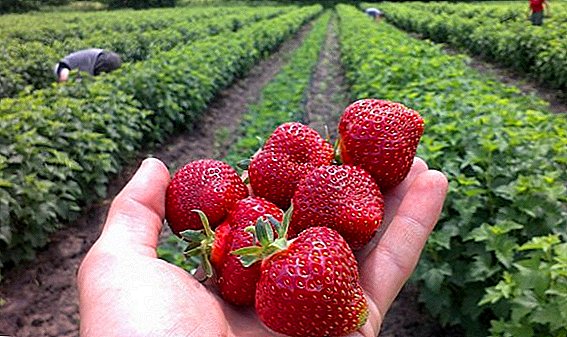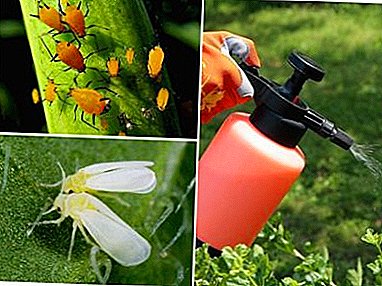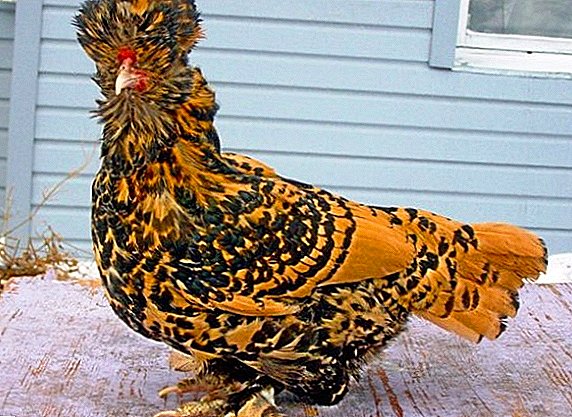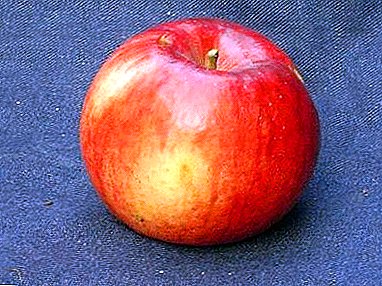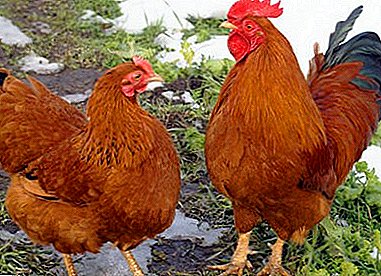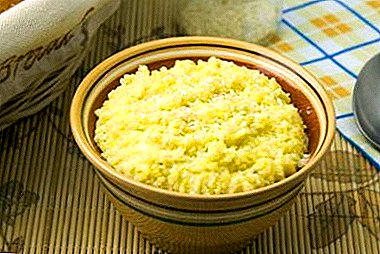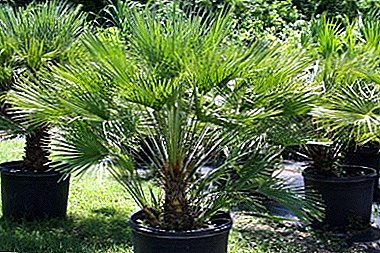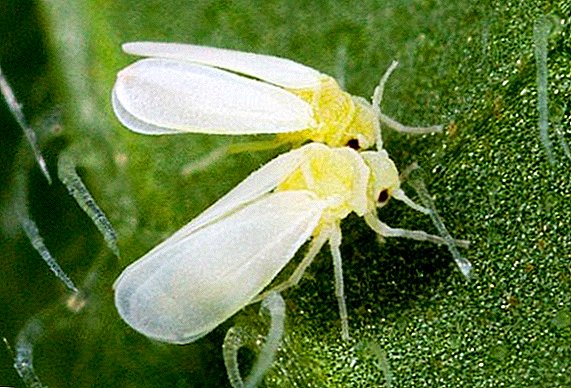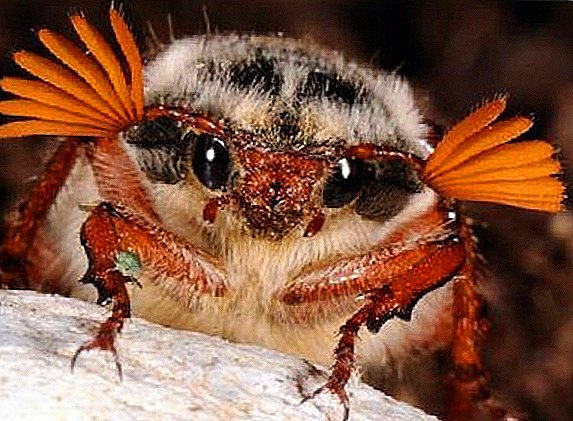 The number of pests and diseases of the potato is proportional to its popularity. Each gardener more than once had to contemplate various kinds of damage in root crops and receive significant losses in harvest due to them. So who eats potatoes, how to deal with harmful insects and continue to prevent their attacks - read about it further in the article.
The number of pests and diseases of the potato is proportional to its popularity. Each gardener more than once had to contemplate various kinds of damage in root crops and receive significant losses in harvest due to them. So who eats potatoes, how to deal with harmful insects and continue to prevent their attacks - read about it further in the article.
Did you know? Of the many varieties of potatoes in the world, La Bonnotte is most valued; its homeland is the island of Noirmoutier. This is the most expensive root vegetable. A kilogram of such a treat will cost you half a thousand euros.
Colorado beetle
If you do not take measures, then these voracious parasites are able to clean themselves to destroy tubers and tops. Colorado, or, as they are called, potato beetles lead the list of the most dangerous pests on the garden because of their appetites and the ability to multiply rapidly.  They are very hardy, they adapt to different climatic conditions and toxic chemicals, which they treat the garden several times a year. In addition, these insects in search of food can overcome considerable distances, endure severe frosts and accumulate in the ground in the same area.
They are very hardy, they adapt to different climatic conditions and toxic chemicals, which they treat the garden several times a year. In addition, these insects in search of food can overcome considerable distances, endure severe frosts and accumulate in the ground in the same area.
At a depth of half a meter, where beetles hibernate, very comfortable conditions are created for them in the cold season. Snow cover does not allow to freeze, keeping warm, and the soil does not freeze to that level.  Therefore, when the earth begins to warm up in spring, the insects awaken and rise to the top. With the onset of heat and the first shoots of potato plantations in beetles, the reproduction period begins.
Therefore, when the earth begins to warm up in spring, the insects awaken and rise to the top. With the onset of heat and the first shoots of potato plantations in beetles, the reproduction period begins.
You can see yellowish egg clutches on the inside of the foliage, of which small slippery pink larvae will appear after a short time.
Did you know? The female of the Colorado potato beetle lays about 4 hundred eggs daily.
Do not wait until the whole clusters of these parasites appear on the leaves. It is necessary to take measures even when planting root crops. To this end, the tubers are treated with drugs, "Tyrant", "Maxim" and only then bury in the ground.
Such a procedure is done in order to ensure good planting of seedlings.
Further, as the potato stalks grow, it becomes more difficult to fight the Colorado potato beetles, since these insects have several periods of calm, which are real both in winter and in summer.  Some adults can spend about three years in the ground. In order to preserve the yield, the owners of small areas have to manually collect new generations of malicious beetles.
Some adults can spend about three years in the ground. In order to preserve the yield, the owners of small areas have to manually collect new generations of malicious beetles.
In large kitchen gardens, the number of pests will be reduced by spraying potatoes with such preparations: Aktellik, Iskra, Karbofos, Bitoksibatsillin, Prestige, Aktara
For those who fear the use of pesticides, a biological remedy, such as Bowerin, is available. With minor attacks of pests, you can use folk remedies for the Colorado beetles.
Virtually all recipes are available to every homeowner and are completely harmless. Some of them offer to treat a potato bed with wood ash.
Others advise you to prepare a spraying solution from calendula, the smell of which is very unpleasant for the insects mentioned. Based on these beliefs, try planting this drug culture between rows of potatoes.
Also it is necessary to give preference to such treatments: “Glow”, “Temp”, “Dilor”, “Marshal”, “Colorado”, “Sumicidin”, “Tsimbush”, “Volaton”, “Novador”.
Important! Timely weeding, loosening the soil and hilling potato shoots help to reduce the population of Colorado beetles and other harmful insects.
Potato moth
These unsightly moths with dirty-gray spotted wings, like the Colorado beetles, migrated to our latitudes from America. Despite their adaptability to the warm climate, today there is practically no place left on the globe where they would not live potato moth.  Adult butterflies live only a few days, managing to give three generations over this period. In closed warehouses and on agricultural plots, the breeding of butterflies is uncontrollable, since these places are inaccessible to predators that feed on these insects.
Adult butterflies live only a few days, managing to give three generations over this period. In closed warehouses and on agricultural plots, the breeding of butterflies is uncontrollable, since these places are inaccessible to predators that feed on these insects.
The peculiarity of these insects - potato pests is that their zone of distribution is limited by a decrease in temperature in winter time to 4 degrees below zero.
And if the mole does not know how to winter on the street, gardeners help him with this, transferring the larvae in potato tubers to storage in the cellar. There, caterpillars develop comfortably until spring and with planting material again fall into the ground.
 Egg laying is difficult - they are so small that it is impossible to see them even from close range. The vital activity of these parasites on solanaceous plants is manifested by the withering and lifeless stems, which eventually die.
Egg laying is difficult - they are so small that it is impossible to see them even from close range. The vital activity of these parasites on solanaceous plants is manifested by the withering and lifeless stems, which eventually die.
The reason for this lies in the heavily damaged leaf fibers, the passages made in them, which the mole clogs up with its excrement.
As a result, the quality and quantity of the crop is greatly reduced, infected tubers are unsuitable for consumption and sale, and the surviving bushes are very weak.
Important! It is possible to protect potatoes from moths, preferring early varieties that ripen to the activity of caterpillars and butterflies.
Developed many pesticides for preventive measures, as well as combating these pests of potatoes.
Biological preparations are effective in large potato areas: Entobacterin, Dendrobacillin, developed on the basis of Bacillus thuringiensis.  Methyl bromide, which is recommended to spray harvested crops, has also proven itself well. Do not forget about competent planting and comprehensive care of plants. First of all, healthy tubers deepen as much as possible when planting, and the bushes regularly weed and spud. Also, it does not hurt to warm the planting material to 40 degrees. Such manipulation will not affect the germination, but eliminates the larvae. Some landowners in the fight against potato moths cost special traps, but this method is effective only on small beds with a slight infection. With the preventive purpose, try to spray the planting solution at the rate of 45 g per 5 l of water.
Methyl bromide, which is recommended to spray harvested crops, has also proven itself well. Do not forget about competent planting and comprehensive care of plants. First of all, healthy tubers deepen as much as possible when planting, and the bushes regularly weed and spud. Also, it does not hurt to warm the planting material to 40 degrees. Such manipulation will not affect the germination, but eliminates the larvae. Some landowners in the fight against potato moths cost special traps, but this method is effective only on small beds with a slight infection. With the preventive purpose, try to spray the planting solution at the rate of 45 g per 5 l of water.
Did you know? To stop the invasion of moths on the world, quarantine has been introduced in many countries. For example, in Ukraine there is a ban on the luck of potatoes on the territory of the state by private traders. In Australia, where the spread of harmful butterflies has reached its apogee, each imported tuber is cooked and disinfected with insecticides. African farmers have learned to use local wasps to control insects.
Medvedka
Among the pests that are dangerous to potatoes, Medvedka is not inferior to the leading positions. In the people of the insect is often called the "mole-cricket", which is explained by its ability to quickly move underground, while emitting specific sounds.
The pest likes to feed on potato tubers, gnawing big holes in them, which affects sprouts and crop yield. In addition, the pest does not tolerate shade over its housing, for this it often destroys the entire bush. In beds with a large population, the bear can completely destroy the sowing.  To preserve the fruits, we need comprehensive measures. To begin their experienced gardeners advise with well-chosen neighborhood for potatoes. Insect does not like marigolds. Therefore, they must be planted between the rows and along the perimeter of the site.
To preserve the fruits, we need comprehensive measures. To begin their experienced gardeners advise with well-chosen neighborhood for potatoes. Insect does not like marigolds. Therefore, they must be planted between the rows and along the perimeter of the site.
Further, the invasion of Medvedok stop eggshell, poured with oil. During its eating the airway of the pest will be blocked by a layer of oil, as a result of which it will die. You can also make a special bait of equal parts of pre-cooked wheat, corn and barley, processed 25 g of "Metaphos". In total, the grain mixture should weigh half a kilogram.
A teaspoon of sunflower oil is added to it and laid out near the burrows a week before the tubers are planted. Such a mixture is scattered between the rows in the period of emergence.  As an alternative, traps made from glass jars recessed into the soil are suitable. Some gardeners are half filled with beer.
As an alternative, traps made from glass jars recessed into the soil are suitable. Some gardeners are half filled with beer.
In the fall, the pest is enticed into small dung-filled pits. For the winter, Medvedka hurries to hide in the warmth, so with the onset of stable cold weather, the contents of the recesses are spread throughout the garden, exposing the larvae to certain death.
Important! Medvedka fears land fertilized with chicken droppings. To do this, it is enough to pour a portion of any perimeter with a diluted concentrate of 2 kg of manure and 10 liters of water (diluted with a mixture of 1: 5 before use).
The insect does not like wet soil, so it can not live in a 20-centimeter layer of mulch. You can also banish it with the help of tincture of onion peel, which is watered in the garden after the rain. By the way, this method is also effective in combating other potato pests.  Among chemical methods give a temporary result granules "Medvetoksa." They are spread around the perimeter of sowing in the furrows and plentifully watered.
Among chemical methods give a temporary result granules "Medvetoksa." They are spread around the perimeter of sowing in the furrows and plentifully watered.
Also in cases of mass reproduction of parasites, watering the root part with a solution of Karbofos at the rate of 50 g per 10 l of water is recommended. But such treatments are unable to solve the problem once and for all. Much more effective were the popular ways of dealing with Medvedka.
Wireworm
If you have seen dense yellow-brown larvae up to 2.5 cm long on your plot, immediately start protecting the potatoes from the wireworm. Otherwise they will spoil the whole bed, turning the roots into a loose sponge.  Some people mistakenly think that these are worms, ignoring their appearance. In fact, these larvae are produced by click beetles, and in the course of their vital activity feed on tubers, roots and stems of the plant. Subsequently, the educated moves are affected by infections and begin to rot.
Some people mistakenly think that these are worms, ignoring their appearance. In fact, these larvae are produced by click beetles, and in the course of their vital activity feed on tubers, roots and stems of the plant. Subsequently, the educated moves are affected by infections and begin to rot.
The fight with the wireworm on potatoes often occurs by chemical or agrotechnical methods. The desired result is possible when spraying the fields with insecticides, but it is worth noting that such methods can over-feed with toxic substances.
As a result, they are well preserved, but will be unsuitable for both pests and people. Based on these beliefs, many farmers are resorting to traditional methods of preserving the harvest.
Important! Discomfort for click beetles and their larvae can be created by liming sour soils.
In places where the wirewinter winters, create unfavorable conditions. In particular, they dig up a bed at the end of October, pulling malicious larvae out of the comfort zone. Thorough loosening is recommended at the beginning of June for the destruction of the Nutcracker eggs. Ultraviolet has a destructive effect on them.  Of particular importance in the fight is the presence of wheatgrass on the garden. First of all, the plant pierces through the tubers, making it difficult for the potatoes to grow. And secondly, is a wireworm's favorite food. Therefore, in the garden such a weed works as a bait.
Of particular importance in the fight is the presence of wheatgrass on the garden. First of all, the plant pierces through the tubers, making it difficult for the potatoes to grow. And secondly, is a wireworm's favorite food. Therefore, in the garden such a weed works as a bait.
Seeding is important not only for the amount of the crop, but also for the expulsion of harmful insects. In cases of such pests of potatoes as wireworms, planting legumes after root vegetables will be ideal. Moreover, this solution will allow to feed the soil with nitrogen.
Nematodes
Nematodes feed on tubers and root tissues. Depending on their location, root and stem diseases are distinguished.  These frightening worms are almost impossible to deduce, since the lifespan of a female-laid cyst is measured in decades.
These frightening worms are almost impossible to deduce, since the lifespan of a female-laid cyst is measured in decades.
For years, you can cultivate potatoes without even knowing the presence of the disease.
It is manifested by yellowing of the lower foliage, withering of the stems, significant underdevelopment and the absence of the ovary. Minor contamination of the area without special analyzes of the soil imperceptible.
Only during the collection of fruits on the roots of the affected bushes are fine visible small grains - these are cysts. 
They have the ability of high-speed movement, they infect the earth with their presence, therefore, anyone with a shovel who can transfer nematodes to a new place.
Potato nematode root manifests itself only on fruits grayish spots with a metallic sheen. On them the skin sometimes exfoliates and the ruptured core is clearly visible. Moreover, during the growing season it is almost impossible to distinguish a sick bush from a healthy one.
Did you know? In France, the potato got accustomed thanks to the agronomist Antoine-Auguste Parmentier, who was forced to resort to psychological tricks so that the locals became interested in his roots. During the daytime he carefully guarded his fields with the help of mercenaries, and at night there was not a soul. The curiosity was torn apart by the whole district, what is so rescuing a respected man in the village, thereby prompting to steal.
The main characteristics of microscopic parasites are resistance to frost, drought and pesticides. Europeans have learned to cope with nematodes, transferring their experience to everyone.
Their farmers dig up contaminated foci and burn or scald patches of soil with boiling water. All inventory and work shoes are carefully processed with formalin.
Stem potato nematode occurs due to infection of the roots. To avoid this, it is important to monitor the quality of the seed, and in the fall to organize the harvesting of weeds, remaining tops and deep plowing of the garden. Infected specimens are burned together with tops, and the remaining root crops are scrupulously washed from the ground. Even after the measures taken in the future to operate the plot for planting potatoes is undesirable.
It will be possible to carry out such plans only after three years, subject to the preliminary cultivation of legumes or vegetable crops at this place.
It is also good to fertilize potato fields with chicken droppings, add urea before planting on the infected areas. For preventive purposes, it is possible to choose more resistant varieties of potatoes for planting.
These are "Platinum", "Zhukovsky Early", "Safo" and "Almaz". Their peculiarity in specific substances that are produced in the root system, depriving nematodes of the ability to feed. Regarding chemical methods of combating these pests, manufacturers offer a wide range of products. Trust earned the drug "Nematicide", which a few weeks before planting contribute to the soil.
But still, pesticides significantly lose compared with the tricks of the proper agricultural technology. Experienced farmers firmly believe that for the destruction of parasites is necessary to know the organization of their livelihoods.
Did you know? In order to get poisoned by potatoes, it is enough to eat one green berry or a kilogram of raw green root crops, which contain solanine in large quantities.
Scoops
Shovels are small butterflies with gray-yellow wings with a purple tint and dark stripes. Their caterpillars in search of food devour potato tubers and tops, making through passages in the tissues.
They become covered with mucus over time and become foci of development of putrefactive microorganisms. The externally infected shrub looks haggard, its leaves are wilted, the stems are deformed, dry in places.
Methods of control depend on the stage of development of the insect. For example, adult individuals of potato scoops are difficult to remove from the fields by chemical means, since they are nocturnal.  They are caught with the help of cut plastic bottles with diluted nectar or spoiled jam. You can use alternative purchased tapes with a sticky base. There should be no weeds in the garden, especially those that have entered the flowering phase, and cereals.
They are caught with the help of cut plastic bottles with diluted nectar or spoiled jam. You can use alternative purchased tapes with a sticky base. There should be no weeds in the garden, especially those that have entered the flowering phase, and cereals.
Such insects will avoid the site well fertilized with nitrogenous substances. It is enough to dilute chicken droppings and water them beds.
Caterpillars scoops, as especially dangerous pests, are destroyed by insecticides such as "Decis", "Tsimbush", "Prestige", "Nemabakt", "Basudin", "Zolon", sprinkling the field during the flowering period of the crop. In addition, the systematic loosening of the soil is important, which contributes to the destruction of the tunnels.  It is possible to deal with the pupae with the help of the annual deep-digging beds. It is best to do this at the end of October, in order to ensure guaranteed death for parasites.
It is possible to deal with the pupae with the help of the annual deep-digging beds. It is best to do this at the end of October, in order to ensure guaranteed death for parasites.
For those who want to save on pesticides, farmers offer a popular method of dealing with shovels, which is to prepare a decoction of wormwood in a ratio of 1 kg per 3 liters. Liquid watered the bushes several times before budding at intervals of 1-2 weeks.
Important! Spraying potatoes with chemicals is recommended no more than two times during the season. Otherwise, the roots will suffer.
Slugs
Perhaps these pests are the most unpleasant. And it's not just about their appearance.Bare slugs eat leaves, leaving behind sticky slippery traces, and eat away the core of the roots.
The appearance of these parasites contributes to a moist warm environment and thick weeds. On potatoes, they are rare, but still love to feast on his young leaves. Many solve the problem by spraying the bushes with pepper solution laid out in between rows of lime, ground black pepper, and wet tissue patches.  Such traps are effective as long as the tops of the substance secreted by the slugs do not stick together. After this point, to get to the slug is not possible. Moreover, it shows activity at night.
Such traps are effective as long as the tops of the substance secreted by the slugs do not stick together. After this point, to get to the slug is not possible. Moreover, it shows activity at night.
To prevent the appearance of these uninvited guests in the garden, regularly weed and loosen the soil. At the same time you destroy the eggs and comfortable conditions for their laying.
It does not hurt to protect the planted area with a shallow groove and pour lime powder, wood ash, pepper into it. Such a barrier is beyond the power of slugs. Under the bushes on which you notice traces of vital activity of the mentioned pests, you need to scatter potash salt. An hour later, repeat the procedure, because the pest, wanting to protect against irritation after contact with a chemical, releases a huge amount of mucus.
Alternatively, try to fall asleep the enemy (literally) with the drugs "Meta", "Thunderstorm".
For those owners who seek to grow an environmentally friendly product, folk methods suggest destroying slugs with water heated to 40 degrees. Thermal effect is also possible when mulching between rows with plastic wrap. But these methods are suitable only if you have planted potatoes only 2-3 rows.
Did you know? The first crop grown in space, it was the potato. This event was recorded in 1995.
Aphid
The appearance of aphids on potatoes does not depend on the specificity of the soil, nor on the cultivation conditions. These pests cause special harm to the plant, but they are dangerous because they transmit various infections and pathogens.  Therefore, it is not surprising that the bushes that have been chosen by aphid soon begin to ache. In addition, the insect has a bad effect on the planting material of root crops.
Therefore, it is not surprising that the bushes that have been chosen by aphid soon begin to ache. In addition, the insect has a bad effect on the planting material of root crops.
Potato fields are most often affected by peach, common, large potato, and buckthorn aphid species. For the year they produce up to 15 generations. Their colonies are visible on the inside of the leaves. For the destruction of winged individuals the drug "Bi-58 New" is very effective. For the purpose of preventive measures, farmers carefully clean the remains of tops and fruits after harvest, eliminate weeds in time, and strive to plant tubers as early as possible.
Khrushchi
Probably everyone knows the traces left behind by the larvae of the May beetles. The omnivorous mercilessly spoils the tubers, eating deep cavities in them. Before him is the task to stock up on energy for a long period of pupation. 
In order not to share the harvest with these creatures, carefully dig the bed in late autumn and spring, loosen the soil between the rows of shoots that have appeared.
All this spoils the conditions for the development of beetles. But for the final result to restrict such procedures is not enough. In the cold season, the larvae can hide from the frost much deeper than it reaches the bayonet of a shovel. Even a plow cannot reach the half-meter depth.
Therefore, it would be advisable to sow lupine perennial grass on the site of potatoes next year. Its roots have a toxic effect on the larvae of the beetles, and over time the food leads to their death.
Did you know? Potato chips were created by chance by American cook George Crum in 1853. This happened because of the capricious customer of the restaurant, who complained of too thick french fries. In retaliation, the cook cut the root vegetable so thinly that the plates shone through.
In addition to agrotechnical subtleties, you can resort to the popular methods of dealing with malicious insects. Among them, watering the bushes with manganese solution (prepared in the proportion of 5 g per 1 liter).
A useful service on your site will have starlings who feed on the Maybugs. To attract them enough to hang trough.  Chemical treatments are carried out by registered insecticides. Among them are "Aktara", "Decis", "Sherpa", "Confidor", "Arrivo". So that the crunches do not spoil the planting material and do not interfere with the full development of the sprouts, treat the tubers before planting with Prestige.
Chemical treatments are carried out by registered insecticides. Among them are "Aktara", "Decis", "Sherpa", "Confidor", "Arrivo". So that the crunches do not spoil the planting material and do not interfere with the full development of the sprouts, treat the tubers before planting with Prestige.
To fight the diseases that hit your garden or garden, you can use the drugs "Abiga-Peak", "Topaz", "Hom", "Titus", "Strobe".In cases of pesticide use, do not forget to follow the recommendations and safety rules in the attached instructions. It is possible to eat potatoes sprayed with poison in a month, when toxic compounds disintegrate.
Now you know who harms potato growing and how to deal with these pests. We hope that our advice will be useful to you to create favorable conditions on your plot to collect a good harvest.


